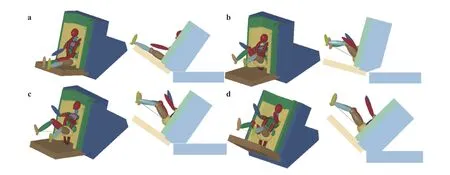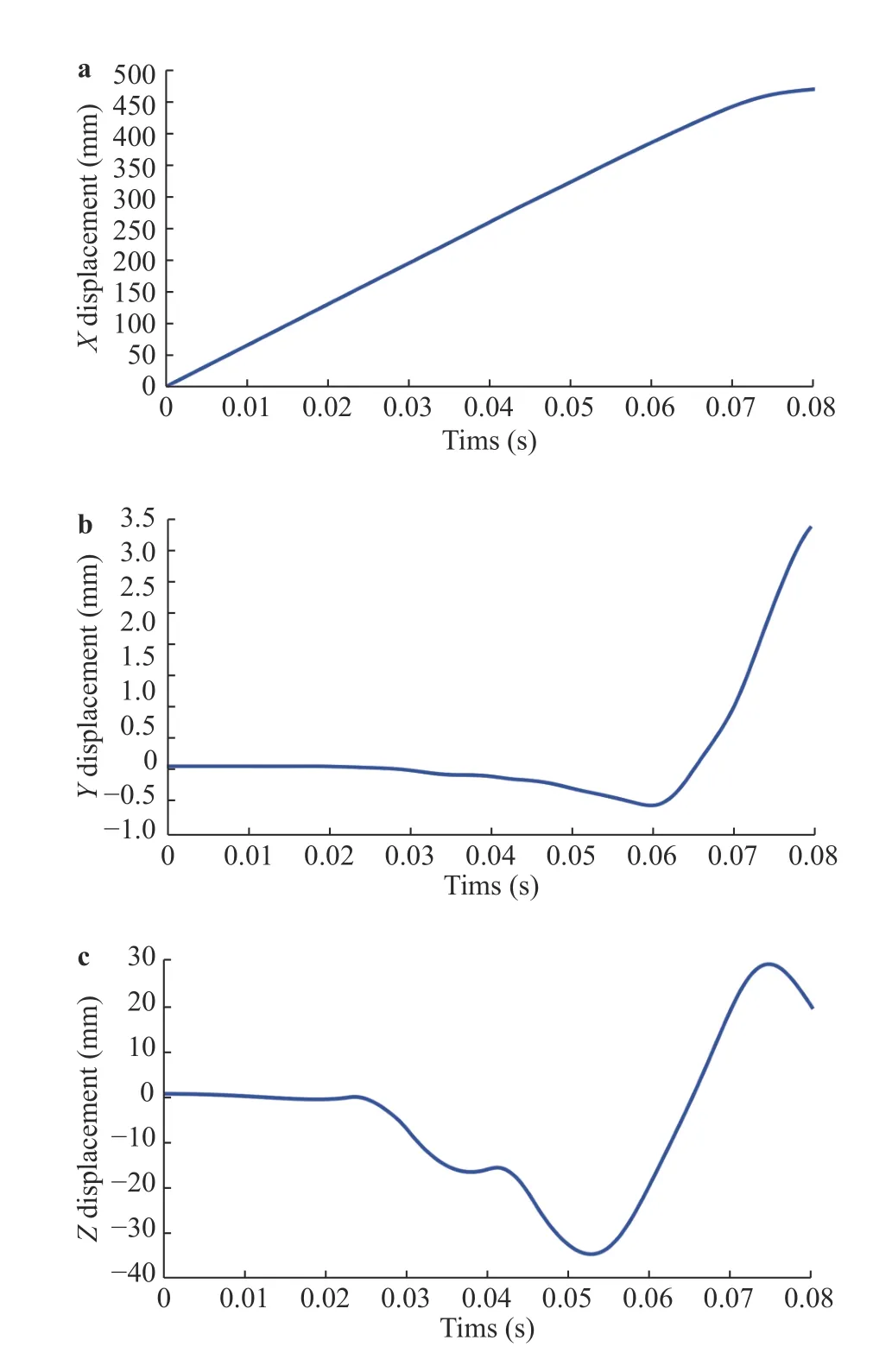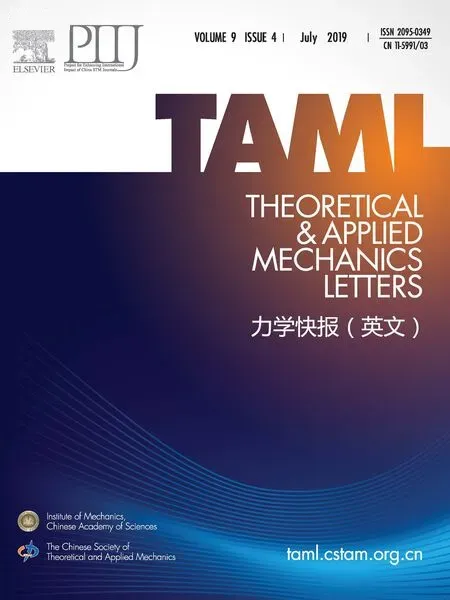Comparative numerical study on the child head injury under different child safety seat angles
2019-08-17RezRzghiHsnBiglriMojtbHsniAlirezKrimi
Rez Rzghi, Hsn Biglri, Mojtb Hsni, Alirez Krimi*
a Department of Mechanical Engineering, University of Tabriz, Tabriz, Iran b Basir Eye Health Research Center, Tehran, Iran c Department of Biomedical Engineering, Faculty of Engineering, University of Isfahan, Isfahan, Iran d Department of Mechanical Engineering, Kyushu University, Fukuoka 819-0395, Japan
Keywords:Child Head injury Child safety seat Accident Finite element
A B S T R A C T It has been shown that annually around 1250 children younger than 15 years old die in traffic accident. The number of children who also injured as a consequence of car accidents is noticeably higher. According to the ECE-R44 regulation the safety of children in the cars, the use of a child safety seat (CSS) is highly recommended. Using a CSS would dramatically diminish the injuries of traffic accidents. However, the posture, especially the angle, of a child when seating on a seat may also affect the amount of injury occurs during the accident. It has been revealed that during the accident only few children remained seated in the standard position, and most of them whether slouched or slanted and turned their head to the side-support of the CSS. Extreme positions, such as leaning forward, escaping from the harness or holding feet were also observed. This study aimed to perform a finite element (FE) study to figure out what angle of seating would result in the least amount of injury to the child head in a typical car crash under the speed of 47 km/h. To do that, a 1.5 years old child dummy (a dummy representing the anthropometry of a 1.5 years old child) has been accommodated on a seat under the angles of 15°, 30°, and 45°. The results revealed.The resulted displacements in the head after the accident were also calculated at X, Y, and Z directions. The results in this regard indicated a higher displacement at X direction whereas the lowest one was seen at Y direction. The results have implications not only for understanding the amount of injury to the child head after the accident under different seating angles, but also for giving an insight to the CSS industries and families to choose the right seating posture for the child in the car to reduce the severity of injury.
In the United States, 663 children ages 12 years and younger died as occupants in motor vehicle crashes during 2015 [1], and more than 121350 were injured in 2014 [2]. Despite the low number of death compared to adults, there has to be a serious effort to reduce this number it as much as possible. The application of child safety seat (CSS) would be an asset in this regard to protect the child and lessen the number of death. A CSS prevents the child to impact vehicle interior structures and it safeguards a belt restraint situation that is planned explicitly for the smaller anthropometry of a child. However, the application of CSS still does not guarantee the safety of a child in its highest level and it is deemed necessary for a child to have a suitable posture while seating on the CSS [3]. A suitable posture here defines as an appropriate angle for the CSS which a child seats on that.
The currently existing test method for evaluating the performance of CSS in the European Union (EU) is ECE-R44 [4, 5].Within this regulation a frontal impact sled test is performed at an impact speed of 50 km/h. Numerical simulations here seem to be useful as they can go beyond the experimental boundaries,such as test condition, dummy size, and parametric data. With these considerations in mind, this study was aimed to conduct a numerical study to investigate the effect of CSS angle on the injury response of children under the accident speed of 47 km/h.To do that, a child dummy at the age of 1.5 years old was positioned on a CSS with the angles of 15°, 30°, and 45°. The injury parameter was defined as the acceleration in the head of dummy in the direction of car movement as this has been considered as the most severe parameter of injury during an accident.
A 1.5 years old dummy was made according to the existing ellipsoid dummy model [6, 7]. The model consisted of 32 rigid bodies that were interconnected by 32 kinematic joints. Mass and inertia properties were attributed to the rigid bodies, while force models were implemented in the joints. The dummy model and its position inside the car compared to the interior equipment are illustrated in Fig. 1.
In order to compare properties of the developed dummy model with the actual hardware dummy, the segment dimensions as well as mass distributions between various body parts are listed in Tables 1 and 2, respectively. The total mass of the dummy was approximately 11.02 kg [8]. Different from the ellipsoid dummy models, these models are characterized by a mesh representing the skin, by flexible bodies representing a fully deformable thorax and abdomen and by additional joint models representing all spinal flexibility.

Fig. 1. a Dummy model, b its location seated at three different angles, including 15°, 30°, and 45°, and c the location of the seat and dummy side in the car
The 35 anthropometric scaling parameters of the 50th percentile adult were derived from RAMSIS anthropometric data-base [9]. These data were used according to the reference provided and acknowledged [10]. An overview of CANDAT mass specifications and resulting model segment mass distribution is given in Table 2.

Table 1 Dimensions of the dummy model [10]

Table 2 Segment mass distribution as specified in CANDAT database and as resulting from human model of 1.5 years old [10].
The developed child model (Fig. 1(a)) positioned in the car(Fig. 1(c)). A mesh of the outer geometry of the CSS was generated and implemented in finite element (FE) model. The FE CSS was considered undeformable, while seat compliance was modeled by means of a contact characteristic between child model and CSS. The child model was positioned on the CSS after which FE belts were wrapped around the child that represented the internal 5-point harness of the CSS (Fig. 1(b))
To evaluate the effect of various seating angles, i.e., 15°, 30°,and 45°, some of the observed postures were simulated in the CSS on the vehicle rear seat model environment that was developed within this study. The seat was considered to be rigid and the accident was occurred under the speed of 13 m/s(47 km/h). To apply the acceleration during the test to the seat,the FMVSS213 standard [11] was used as presented in Fig. 2 .
This study was aimed to conduct a comparative numerical study to recommend the safest seating angles for the child to reduce the amount of injury as a consequence of traffic accident.To do that, a 1.5 years old dummy model was created and positioned in a CSS inside a car under the seating angles of 15°, 30°,and 45°. The car was impacted by a rigid wall at the speed of 47 km/h and the resulted injury in the child head was computed and reported.

Fig. 2. Resulted acceleration as a consequence of accident versus the time [11], g means acceleration of gravity.
The amounts of head injury criterion acceleration versus the simulation time under the seating angles of 15°, 30°, and 45°, are depicted in Fig. 3. The results revealed that a higher acceleration in the head under the seating angle of 15° while the lowest one was observed at 45°. That is, the acceleration in X direction,which is the moving direction of the car, was observed to be 1000 m/s2under the angle of 15° whereas this value reduces to 800 m/s2under the seating angle of 45°. This goes to show us how the seating angle can affect the acceleration, which is one of the most serious injury parameter during the accident. A head injury occurs as a result of car accident can be as mild as a bump, bruise (contusion), or cut on the head. It can also be a concussion, a deep cut or open wound, broken skull bones, internal bleeding, or damage to the brain. Head injuries are one of the most common causes of disability and death in children.

Fig. 3. Head injury criterion acceleration versus the simulation time under the angles of 15°, 30°, and 45°

Fig. 4. Location of the seat and dummy in the car from the isometric and side views in a initial, end of the simulation under the angle of b 15°,c 30°, and d 45°

Fig. 5. a X, b Y, and c Z displacements of an element in the nose of the child versus the simulation time under the seating angle of 30°
The initial and final position of the child and CSS during the accident under the seating angles of 15°, 30°, and 45°, are demonstrated in Fig. 4. The figures are shown both from the isometric and side views to provide a better understanding of how the seating angles can affect the position of a child after the accident. The results revealed that by increasing the seating angle of CSS the Z displacement of the child head is also increasing. For example, the X, Y, and Z displacements of the child head under the angle of 45° which showed the least acceleration were calculated and indicated in Fig. 5. The results in this regard showed the highest displacement in X direction which was a moving direction with 480 mm. This can be considered as a high value which can also bring about a high dislocation in cervical spine of the child following by serious injuries. The Y displacement found to be small which is a result of belt supports the child not to move laterally. The Z displacement also minimized due to the fastening of belt during the accident. However, the X displacement as pointed out is still high and there should be an effort in this regard to find a way to minimize these values. It has been shown that the injury may occur to baby depend on the dynamics of the seat and the human body, therefore, here although we computed the resulted acceleration in the head, it can be changed according to the condition of the model [12]. In addition, the safety design for the angles provided here might help industries as well as safety assessing associations to provide a more accurate calculation on the level of injury may occur after accident [13, 14].
The results of the concurrent study well investigated the role of seating angles on the amount of injury to the child head after the traffic accident. The results suggested the angle of 45° which can minimize the acceleration in the child head with around 20%. This study also has some limitations such as, the age of the dummy which could be considered in a wide variety at different ages. The only injury parameter which reported here was acceleration to the head which could be strengthened using other mechanical parameters. In addition, the seat model was considered as a rigid material, which is a limitation of this study. It should be noted that, this is the first preliminary study, which considered the role of seating angles on the injury to the child head, and for sure more research in this regard is required.
This study employed a numerical FE approach to calculate the acceleration and displacement of a 1.5 years old dummy model after a traffic accident. The seating angles were chosen to be 15°, 30°, and 45° to enable us understand the angle role in controlling the injury to the child head. The results well revealed that the seating angle of 45° can well minimize the acceleration and displacement in the head of the child compared to the 15°and 30°. The results have implications for car and CSS industries to minimize the injury to children body during car accident.
杂志排行
Theoretical & Applied Mechanics Letters的其它文章
- Response to (Comment on the paper "Theoretical & Applied Mechanics Letters 7 (2017) 235-242”)
- Comment on the paper “Theoretical & Applied Mechanics Letters 7 (2017)235-242”
- Analytical modeling for rapid design of bistable buckled beams
- Direct method for a Cauchy problem with application to a Tokamak
- Thermal explosion and irreversibility of hydromagnetic reactive couple stress fluid with viscous dissipation and Navier slips
- On the Weissenberg effect of turbulence
